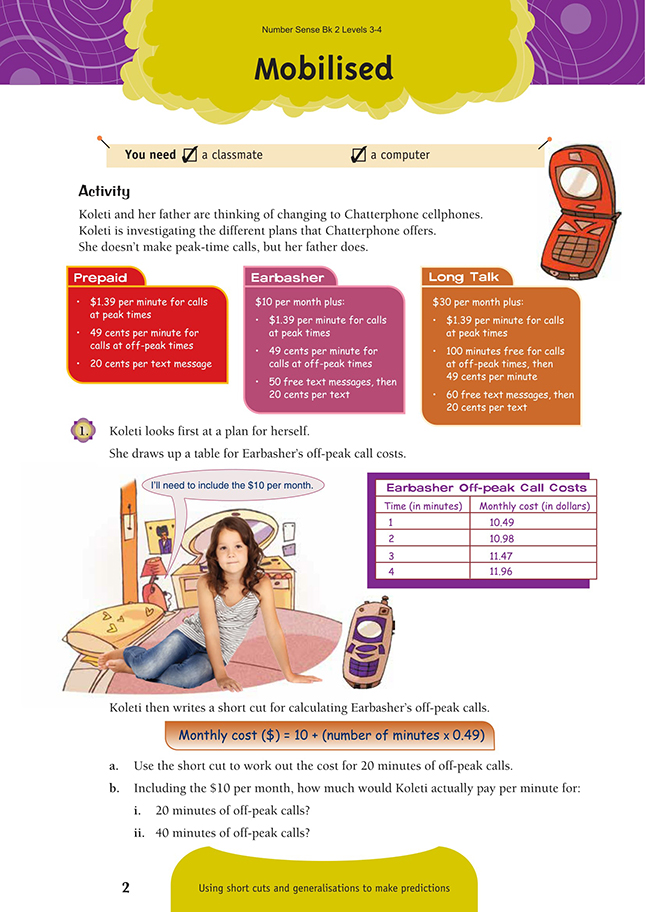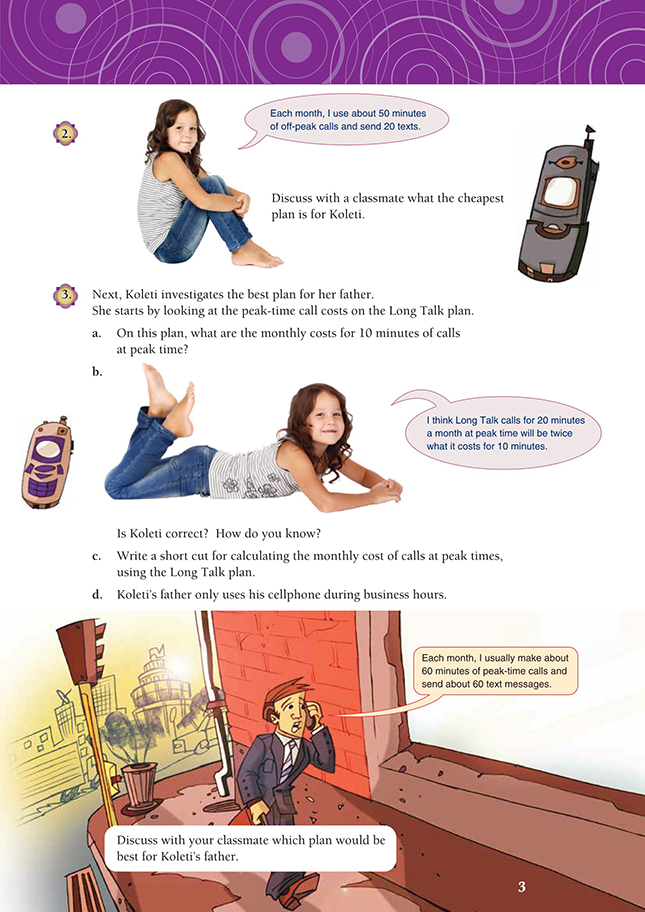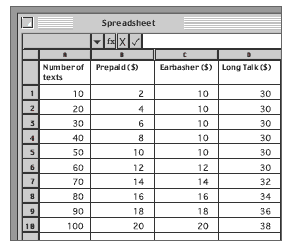This is a level 5 number activity from the Figure It Out series. It relates to Stage 8 of the Number Framework.
A PDF of the student activity is included.
Click on the image to enlarge it. Click again to close. Download PDF (506 KB)
use a calculator to help multiply decimals
Number Framework Links
Use this activity to:
• encourage transition from advanced additive strategies (stage 6) to advanced multiplicative strategies (stage 7) for the multiplication of decimals
• help the students to consolidate advanced multiplicative strategies (stage 7).
FIO, Levels 3-4, Number Sense and Algebraic Thinking, Book Two, Mobilised, pages 2-4
A classmate
A computer
This activity involves the comparison of three cellphone plans with different rating schedules for peak-time calls, off-peak calls, text messaging, and monthly fees. The activity is suitable for students who are using strategies based on multiplication and division to solve problems with decimals and who can already order decimals up to three places.
Koleti calculates options according to the various payment plans and her pattern of use. These calculations are clearly explained in the Answers.
For the Earbasher off-peak call costs explored in question 1, ask: Why is 1 minute of time per month calculated as $10.49 when the off-peak calls are only 49 cents per minute? (This plan has a $10 basic charge per month plus call time. It would cost $10 per month even if Koleti didn’t call anyone.) Get the students to test Koleti’s short cut against the values listed in the table on page 2 and then have them use the short cut to calculate the cost for 20 off-peak minutes for question 1a. They could work in pairs to find a suitable generalisation.
The values for question 4 need to be entered into a spreadsheet so that the students can generate a scatterplot graph. The students could work in pairs to complete the spreadsheet and the graph before they discuss the best call plan for Koleti. They need to be aware of how many free texts each call plan allows because this will affect their calculations. Encourage the students to justify their ideas and the limitations of each option.
When the students are making a scatterplot in question 4b, check that they understand the features of presentation, including a title (What does the graph show?), the labels for the horizontal axis (number of texts) and the vertical axis (cost in dollars), and the inclusion of a key to identify the company represented by each symbol. To get the computer to create the graph, the students need to use the XY (scatter) option. (For general information on the use of spreadsheets, see Answers
and Teachers’ Notes: Algebra, Figure It Out, Level 3, pages 26–27.)
For question 5, the students need to understand the decimal relationship between dollars and cents (1 cent = $ 1/100 ). Koleti’s prepaid short cut can be expressed as:
Cost in cents = number of texts x 20 cents
Cost in dollars = number of texts x 0.2 dollars
Cost in dollars = number of texts x 2/10 dollars (or 1/5 dollars)
Cost in dollars = number of texts ÷ 5.
Some students may find this confusing because multiplication usually makes things bigger. Point out that “multiplied by” can be thought of as “of”, for example, 20 x 0.2 is 20 lots of 0.2.
Extension
You could extend this activity by asking the students to vary the scenarios and recalculate the costs or by getting them to investigate real-life cellphone deals.
Challenge them to create a cellphone package that is ideal for students of their age.
Answers to Activity
1. a. $19.80. (10 + [20 x 0.49])
b. i. 99c. (19.80 ÷ 20)
ii. 74c. (10 + [40 x 0.49] = 29.60.
29.60 ÷ 40 = 74c.)
2. Discussion will vary. Based on Koleti’s current usage, the monthly cost of each plan for her would be: Prepaid: $28.50; Earbasher: $34.50; Long Talk: $30. Prepaid is the cheapest option for Koleti. However, you might recommend Long
Talk because it is almost the same cost but Koleti can double her calls and triple her texts with the Long Talk plan without any extra cost.
3. a. $43.90. (30 + [10 x 1.39])
b. No. The number of minutes doubles, but the $30 monthly fee stays the same.
(30 + [20 x 1.39] is $57.80, not $87.80 or $43.90 x 2.)
c. Monthly cost = 30 + (number of min x 1.39)
d. Based on his current usage, the monthly cost of each plan for Koleti’s father would be: Prepaid: $95.40; Earbasher: $95.40; Long Talk: $113.40. The Prepaid and Earbasher plans are the same cost, but you might recommend that Koleti’s father use the Prepaid plan because it would be the cheaper plan for any month in which he made fewer calls. (The $10 Earbasher monthly fee is the equivalent of just over 7 minutes of peaktime calls.)
4. a.
b.
.gif)
c. i. Prepaid
ii. Prepaid or Earbasher
d. Prepaid if she sends fewer than 50 texts in any month. For 50 texts or more in any
month, Prepaid and Earbasher would cost her the same.
5. Cost in dollars = number of texts x 0.2
Cost in dollars = number of texts ÷ 5



